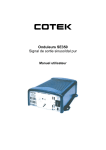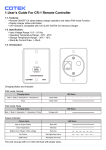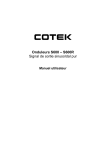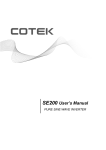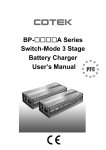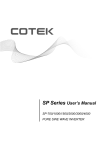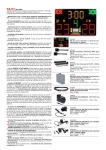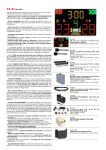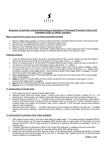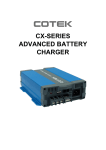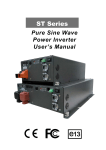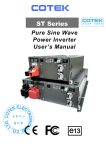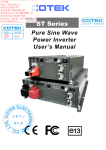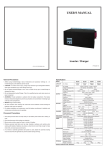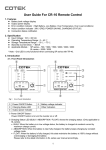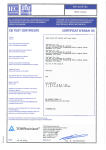Download COTEK S150, S300, S500 User Manual
Transcript
S Series User’s Manual S150/300/500 PURE SINE WAVE POWER INVERTER Table of Contents 1. Safety Instructions ....................................................... 1 1-1. General Safety Precautions ............................................ 1 1-2. Precautions When Working with Batteries ...................... 1 2. Functional Characteristics Introduction .................... 2 2-1. Features ......................................................................... 2 2-2. Mechanical Drawing ....................................................... 2 2-3. S150 Specification ......................................................... 3 2-4. S300 Specification ......................................................... 4 2-5. S500 Specification ......................................................... 5 3. Instructions ................................................................... 6 3-1. Front Panel Introduction ................................................. 6 3-2. Rear Panel Introduction.................................................. 8 3-3. AC Safety Grounding ..................................................... 9 3-4. Making DC Wiring Connections...................................... 9 3-5. Installation .....................................................................10 4. Troubleshooting ......................................................... 11 5. Maintenance ............................................................... 12 6. Warranty...................................................................... 12 1. Safety Instructions WARNING! Before installing and using the inverter, please read the following safety information carefully. 1-1. General Safety Precautions 1-1-1. Do not expose the inverter to water, mist, snow, or dust. To reduce the risk of hazard, do not cover or obstruct the ventilation shaft. To avoid overheating, do not install the inverter in a zero-clearance compartment. 1-1-2. To avoid the risk of fire and electronic shock, make sure that existing wiring is in good electrical condition and not undersized. Do not operate the inverter with damaged or substandard wiring. 1-1-3. There are some components in the inverter that can cause arcs and sparks. To prevent from fire or explosion, do not put batteries, flammable materials, or anything that should be ignition–protected around the inverter. 1-2. Precautions When Working with Batteries 1-2-1. If battery acid contacts your skin or clothing, you need to wash it out immediately with soap and water. If acid enters into your eyes, immediately flush your eyes with running cold water for at least 20 minutes and get medical attention immediately. 1-2-2. Never smoke or make a spark or flame in the vicinity of batteries or engines. 1-2-3. Do not drop metal tools on the battery. The resulting spark or short-circuit on the battery or other electrical parts may cause an explosion. 1-2-4. Remove personal metal items such as rings, bracelets, necklaces, and watches when working with a lead-acid battery. A lead-acid battery may produce a short-circuit current whose temperature is high enough to weld these metal items and cause a severe burn. 1 2. Functional Characteristics Introduction 2-1. Features z Low Frequency transformer design is capable of driving high reactive and capacitive loads z Power ON / OFF remote control (Green Terminal) z Input & output fully isolation z Thermal control fan z Input protection烉Reverse Polarity (Fuse) / Under Voltage / Over Voltage z Output protection烉Short Circuit / Overload / Over Temperature 2-2. Mechanical Drawing S150 / 300 drawing Model S150 S300 S500 A (mm) 188 215 314 B (mm) 41.5 41.5 42.5 S500 drawing C (mm) 105.0 132.0 196.0 D (mm) 132 154 192 E (mm) 73 73 89 2 2-3. S150 Specification Specification Item AC Voltage Rated Power Surge Power Waveform Frequency Power Factor Allowed Standard Receptacles No Load Current Draw DC Voltage Input Voltage Range Efficiency (Typ.) Protection Remote Control Working Temperature Storage Temp. & Humidity Safety Standards Isolation Resistance EMI Conduction & Radiation EMS Immunity Model No. S150-124 S150-212 S150-112 100 / 110 / 120 VAC ± 5% S150-224 220 / 230 / 240 VAC ± 3% 150W 200W Pure Sine Wave (THD < 6.0%) 50 / 60Hz ± 0.5% cosθ -90° ~ cosθ +90° Schuko / Australia / UK / GFCI / NEMA Universal / IEC 0.20A 0.16A 0.22A 0.16A 12V 24V 12V 24V 10.5~15.0 21.0~30.0 10.5~15.0 21.0~30.0 VDC VDC VDC VDC 87% 88% 87% 88% Overload, Short Circuit, Reverse Polarity (Fuse), Over / Under Input Voltage, Over Temperature. Yes, On/Off controlled by external switch 0 ~ 40 ɗ -30 ~ 70ɗ, 10~95% RH Certified UL 458 (Only for “GFCI” receptacles) Certified EN 60950-1 I/P – O/P: 100M Ohms / 500VDC Certified EN 55022; EN 61000-3-2, -3-3, -6-3; Certified FCC class B EN 61204-3 Certified EN 61204-3; EN 61000-6-1; ---EN55024; ENV50204; IEC 61000-4-2, 3, 4, 5, 6, 8, 11 E-mark Fan Cooling Dimensions (WxHxD) Weight Certified CISPR25 ISO 11452-2; ISO 7637-2 Thermostatically controlled 132x73x188 mm / 5.20x2.87x7.40 inch 2.84kg ---- NOTE烉The specifications are subject to change without notice. 3 2-4. S300 Specification Specification Item AC Voltage Rated Power Surge Power Waveform Frequency Power Factor Allowed Standard Receptacles No Load Current Draw DC Voltage Input Voltage Range Efficiency (Typ.) Protection Remote Control Working Temperature Storage Temp. & Humidity Safety Standards Isolation Resistance EMI Conduction & Radiation EMS Immunity Model No. S300-124 S300-212 S300-112 100 / 110 / 120 VAC ± 5% S300-224 220 / 230 / 240 VAC ± 3% 300W 400W Pure Sine Wave (THD < 6.0%) 50 / 60Hz ± 0.5% cosθ -90° ~ cosθ +90° Schuko / Australia / UK / GFCI / NEMA Universal / IEC 0.24A 0.28A 0.26A 0.28A 12V 24V 12V 24V 10.5~15.0 21.0~30.0 10.5~15.0 21.0~30.0 VDC VDC VDC VDC 89% 89% 89% 89% Overload, Short Circuit, Reverse Polarity (Fuse), Over / Under Input Voltage, Over Temperature. Yes, On/Off controlled by external switch 0 ~ 40 ɗ -30 ~ 70ɗ, 10~95% RH Certified UL 458 (Only for “GFCI” receptacles) Certified EN 60950-1 I/P – O/P: 100M Ohms / 500VDC Certified EN 55022; EN 61000-3-2, -3-3, -6-3; Certified FCC class B EN 61204-3 Certified EN 61204-3; EN 61000-6-1; ---EN55024; ENV50204; IEC 61000-4-2, 3, 4, 5, 6, 8, 11 E-mark Fan Cooling Dimensions (WxHxD) Weight Certified CISPR25 ISO 11452-2; ISO 7637-2 Thermostatically controlled 154x73x215 mm / 6.06x2.87x8.46 inch 4.06kg ---- NOTE烉The specifications are subject to change without notice. 4 2-5. S500 Specification Specification Item AC Voltage Model No. S500-124 S500-212 S500-112 100/110/115/120 VAC ± 5% 200/220/230/240 VAC ± 3% Rated Power 500W Surge Power 500W~625W(1min) , 625~750W(10s) Waveform Pure Sine Wave (THD < 3.0%) Frequency 50 / 60Hz ± 0.5% Power Factor Allowed cosθ -90° ~ cosθ +90° Standard Receptacles S500-224 Schuko / Australia / UK / Universal GFCI / NEMA No Load Current Draw 0.5A 0.4A 0.7A 0.4A DC Voltage 12V 24V 12V 24V Input Voltage Range 10.5~16.0 VDC 21.0~32.0 VDC 10.5~16.0 VDC 21.0~32.0 VDC Efficiency (Typ.) 89% 89% 89% 89% Protection Overload, Short Circuit, Reverse Polarity (Fuse), Over / Under Input Voltage, Over Temperature. Remote Control Yes, On/Off controlled by external switch Working Temperature -20 ~ 40 ɗ Storage Temp. & Humidity -30 ~ 70ɗ, 10~95% RH Safety Standards Isolation Resistance EMI Conduction & Radiation EMS Immunity Certified UL 458 (Only for “GFCI” receptacles) Certified EN 60950-1 I/P – O/P: 100M Ohms / 500VDC Certified EN 55022; EN 61000-3-2, -3-3, -6-3; EN 61204-3 Certified FCC class B Certified EN 61204-3; EN 61000-6-1; EN55024; ENV50204; ---- IEC 61000-4-2, 3, 4, 5, 6, 8, 11 E-Mark Certified CISPR 25 ISO 11452-2; ISO 7637-2 ---- Fan Cooling Thermostatically controlled Dimensions (WxHxD) 192x90x314 mm / 7.56x3.54x12.36 inch Weight 6.00kg NOTE烉The specifications are subject to change without notice. 5 3. Instructions S150, S300 and S500 series are very reliable, portable, and fully protected. These pure sine inverters are used in a wide range of applications such as vehicles, office equipment, home entertainment, electronic appliances, etc. To have the most effective power inverter performance, it must be installed and used properly. Please read the instructions of this manual before you install and operate this model. 3-1. Front Panel Introduction S150/300 Front Panel Model S500 Front Panel S150 / S300 / S500 A ˕ B ˕ AC output socket Main switch C ˕ D ˕ Remote port Power status LED A 烉 3-1-1. AC output (Outlet Sockets available) ˕ 6 B and remote port˕ C烉 3-1-2. Main switch˕ The 3-stage switch is for turning the unit ON/OFF or putting in to the remote mode. 3-1-1-1. Before installing the inverter, make sure the main switch is set to "OFF ". 3-1-1-2. Before using the remote unit, make sure the main switch is set to "REMOTE ". 3-1-1-3. Ensure the remote control contact is off. 2 3-1-1-4. Remote Port烉Place 0.75mm and Screw type cable between the remote port and the panel. 3-1-1-5. To turn ON / OFF inverter via remote switch. REMOTE PORT MODE I MODE II D 烉 3-1-3. Power Status LED ˕ LED Status 7 Description Solid Green AC Power OK Fast Red Blink OVP LED Status Description Slow Red Blink Intermittently Red Blink Solid Red UVP OTP OLP 3-2. Rear Panel Introduction S150/300 Rear Panel Model S500 Rear Panel S150 / S300 / S500 M N DC input terminal Ventilation mesh O Chassis ground 3-2-1. Input terminals烉 Connect the input terminal to 12v / 24V battery or other 12V / 24V power source. ˰為˱represents positive, and˰炼˱represents negative. Reverse polarity connection will blow the internal fuse and may damage inverter permanently. 3-2-2. Ventilation mesh烉 Maintain at least a 3-inch distance from anything surrounding it. 3-2-3. Use wire # 8 AWG to connect Chassis ground with Vehicle Chassis. WARNING! Do not combine the 12V model with 24V battery or the unit will be destroyed immediately. Operating with the inverter without a proper ground connection may cause an electrical safety hazard. Damage caused by reversed polarity is not covered by the warranty. Ensure the power switch is in the OFF position before putting the battery in. 8 3-3. AC Safety Grounding Neutral Grounding (GFCI’S)烉 110V models烉The neutral conductor of the AC output circuit of the Inverter is automatically connected to the safety ground during inverter operation. This conforms to National Electrical Code requirements that separately derived from AC sources (such as inverters and generators) which have their neutral conductors tied to ground in the same way as the neutral conductors from the utility tied to ground at the AC breaker panel. For models configured with a transfer relay, while AC utility power is present and the Inverter is in bypass mode, this connection (the neutral of the Inverter’s AC output to input safety ground) is not present so that the utility neutral is only connected to ground at your breaker panel, as required. COTEK has tested the following GFCI-properly when connected to the output of the Inverter. WARNING! Never connect the inverter’s output to the AC distribution grid, such as the household AC wall outlet. It will damage the Inverter. 220V models烉There is no connection made inside the inverter from either the line or neutral conductor to safety ground. 3-4. Making DC Wiring Connections The DC cables should be as short as possible (less than 6 feet / 1.8 meters ideally) The size of the cable should be thick enough to limit the voltage drop to less than 2% when carrying the maximum input current to prevent frequent low-input voltage warnings, and shutdown. The following sizes of cables and fuses are recommended for up to 6 ft. distance between the batteries and the inverter. WARNING! The fuse must be installed on positive cable. Failure to place a fuse on “+” cables running between the inverter and battery may cause damage to the inverter and will void warranty. 9 Increasing S500 DC cable size helps improve the situation. COTEK recommends the following cables for optimum inverter performance. (Apply both 110V and 220V versions) Model Wire AWG Inline fuse S500-112 S500-124 #8 # 10 ʁ125A ʁ80A S500-212 S500-224 #8 # 10 ʁ125A ʁ80A NOTE烉Batteries are capable of providing very large currents in case of short circuit. The fuse should be as close to the positive battery terminal as possible. Use Bussmann ANN series fuses (will also require Fuse Block 4164) or equivalent. 3-5. Installation Before connecting your applications to the inverter, always check the power draw of your appliances. The inverter can supply surge power for a short time so as to start up electrical equipment such as motors and pumps which need more power while starting up. When all the above requirements are satisfied and all connections are made, it’s time to turn on the inverter by switching the power to ‘ I ’ position. The sine wave filters provide sine wave output voltage when driven from the AC outlet. To save the battery power, you are highly recommended to turn off the inverter when it is not being used. DC input voltage status as follows烉 Model DC Input Over Voltage Shut-down Restart DC Input Under Voltage Shut-down Restart S150/S300 12V models 15.3VDC 14.8VDC 10.5VDC 12.5VDC S150/S300 24V models 30.6VDC 29.6VDC 21.0VDC 25.0VDC S500 12V models 16.0VDC 14.5VDC 10.5VDC 12.5VDC S500 24V models 32.0VDC 29.0VDC 21.0VDC 25.0VDC 10 3-6. DC Input (Outlet sockets available) 4. Troubleshooting WARNING! Do not open or disassemble the inverter. Attempting to service the unit yourself may cause the risk of electrical shock or fire. Problems and Symptoms Possible Cause Solutions No output voltage, the LED glows Red. 11 a. Power status light is blinking red fast. Over input voltage. Check input voltage. Discharge the battery. b. Power status light is blinking red slowly. Low input voltage. Charge the battery. Check connections and cable. c. Power status light is blinking red intermittently. Thermal shutdown Improve ventilation. Make sure ventilation openings in the inverter are not obstructed. Lower ambient temperature. d. Power status light is blinking red steadily. Short circuit, Wiring error, Overload Check AC wiring for short circuit. Remove load. 5. Maintenance Very little maintenance is required to keep your inverter operating properly. You should clean the exterior of the unit periodically with a damp cloth to prevent accumulation of dust and dirt. At the same time, tighten the screws on the DC input terminals. 6. Warranty We guarantee this product against defects in materials and workmanship for a period of 24 months from the date of purchase and will repair or replace any defective power inverters if you directly return them to us with postage paid. This warranty will be considered void if the unit has been misused, altered, or accidentally damaged. COTEK is not liable for anything that occurs as a result of the user’s fault. 12 No.33, Sec. 2, Renhe Rd., Daxi Dist., Taoyuan City 33548, Taiwan Phone烉+886-3-3891999 FAX烉+886-3-3802333 http烉// www.cotek.com.tw 2015.01._A1
















